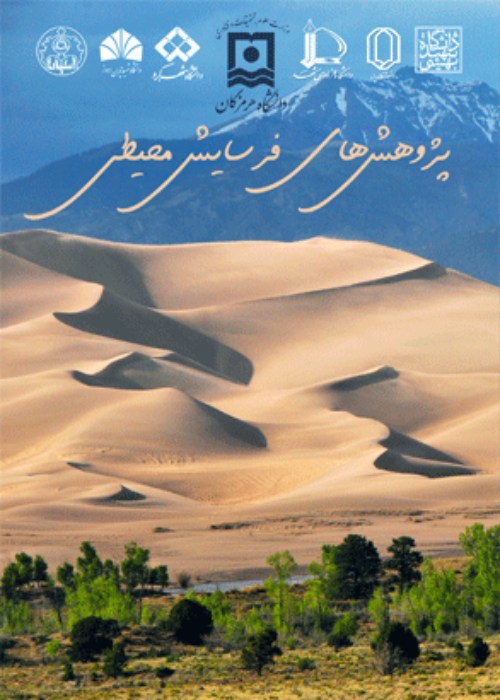The role of land use changes and rainfall on soil erosion rate in Evard watershed, Nekarood
Soil erosion is very obvious and noticeable in Iran, where a large part of it is a desert and the soil does not have a suitable cover. In order to reduce soil erosion and control it, it is necessary to identify factors affecting soil erosion. Land exploitation methods, forest and pasture exploitation, creation of residential and urban areas, geological conditions, precipitation, weather factors, etc. are some of the factors that affect the intensity of erosion in the region. Therefore, knowing the quantitative values of soil erosion is effective in accurately estimating the adverse, hidden, and intangible effects of erosion
In this research, the Revised Universal Soil Loss Equation (RUSLE) Model has been used. The amount of soil erosion in the basin was calculated in two 20-year periods (1980-2000 and 2000-2020). This soil erosion model is calculated through six factorsA=R×K×L×S×C×P (R) the Rainfall erosivity factor, (k) soil erodibility factor, (LS) are slope length and slope degree factors respectively, (c) vegetation management factor, and (P) soil protection factor. The data in this research for the implementation of this model including the rainfall erosivity factor (R), topography including slope length and slope degree (LS), and vegetation management (C) were prepared from the Google Earth Engine system. The soil erodibility factor (K) was obtained from the natural resources report. The BLM model was also used to estimate the evaluation of the RUSLE model. The Google Earth Engine system was used to prepare the land use maps of each of the 20-year periods. The land use map of the first period was prepared using the supervised classification method and calling Landsat 5 images, and The land use map of the second period was done using the CGLS-LC100 product, which is produced and updated at the Copernicus Global Earth Center and using Sentinel satellite images
By analyzing the obtained maps, the rain erosion factor for the first period (1980-2000) has an average of 2.02, the minimum value is 1.80 and the maximum is 2.29, and the second period (2000-2020) is from 1.55 to 2.07 is variable, its average is 1.783. The erodibility factor of the region's soils varies from 0 to 0.349 and its average value is 0.0264. The topography factor of the studied basin varies from 0 to 250 and its average value is 8.77. The vegetation management factor varies between 0.181 and 0.505 and its average is 0.353. This factor varies between 0.315 and 0.494 in the second period, and its average is 0.429 and has an increasing trend compared to the first period, which indicates the decrease of vegetation in the study area compared to the first period. The ground protection factor is also considered to be 1. To calculate the annual average soil erosion rate of the Award Basin in the first period (1980-2000), the various factors of the RUSLE model were converted to the same raster format and cell size, and coordinate system. To determine the risk of soil erosion, the produced layers including the rainfall erosivity layers, soil erodibility, topography, vegetation and soil protection factor were multiplied with the help of the Spatial Analyst extension of the ArcGIS program. The amount of annual loss of soil in terms of (tons per hectare per year) was obtained on a cell-by-cell basis. According to the results, the amount of erosion in the first period varies from 0 to 59.62 tons per hectare and its average is 1.64. The highest amount of soil erosion is in the middle and eastern regions with high slopes. In the second period, the layers of the soil erodibility factor, topography and soil protection factor are the same as in the first period because they are considered constant. The amount of erosion in the area in the second 20-year period varies from 0 to 63.38 tons per hectare, and its average is 1.75 and shows an increasing trend compared to the first period. The RMSE, MAE and MSE statistical indices were used to evaluate the accuracy of the RUSLE model and the degree of agreement of its erosion classes with the output of the BLM based on the map of sampling points. Examination of the values of the mentioned indicators showed that the root mean square error, mean absolute error and mean square error statistics in the RUSLE model have low values of 1.23, 0.96 and 1.52, respectively, as a result this model has It is a small error. After preparing the land use map for the first period, it was determined that in this period, the studied basin includes four land uses: forest, agriculture, pastures and woodlands, and residential. In the second period, there have been forest uses, destroyed forests, agriculture, pastures and woodlands, and residential areas. Then the land use maps prepared in the Google Earth Engine in two periods were transferred to the GIS environment system and the area of each of the above uses was obtained. The area of forests in the studied basin has decreased by 1590.956 hectares and 2014.827 hectares have been added to the area of degraded forests. Also, 2128/368 hectares have been added to the area of agriculture in this basin, and 2557/865 hectares have also decreased from the area of pastures in this area. It should be noted that 5.6266 hectares have been added to the area of residential areas of this basin.Click here and insert your abstract text. Click here and insert your abstract text. Click here and insert your abstract text. Click here and insert your abstract text. Click here and insert your abstract text. Click here and insert your abstract text. Click here and insert your abstract text. Click here and insert your abstract text. Click here and insert your abstract text. Click here and insert your abstract text. Click here and insert your abstract text. Click here and insert your abstract text. Click here and insert your abstract text. Click here and insert your abstract text. Click here and insert your abstract text. Click here and insert your abstract text.
The findings of this research in two 20-year periods (1980 2000) and (2000 2020) in the studied area show that the amount of precipitation in the second period has decreased compared to the first period. The amount of Rainfall erosivity in the first period had a minimum value of 1.80 and a maximum value of 2.29. In the second period, its value varied between 1.55 and 2.07. Thus, the amount of precipitation in the second period did not greatly affect the process of increasing soil erosion. However, the examination of the pictures and maps prepared on the amount of land use changes shows that the amount of forest and pasture area in this region has decreased and the area of destroyed forests and agricultural and residential lands has been added. Therefore, the role of land use changes in increasing soil erosion is significant. The research results of Teimouri (2018), Mayahi (2021) and Arkhi (2022) also confirm that increasing rainfall, changing land use and reducing vegetation are effective in increasing soil erosion.
- حق عضویت دریافتی صرف حمایت از نشریات عضو و نگهداری، تکمیل و توسعه مگیران میشود.
- پرداخت حق اشتراک و دانلود مقالات اجازه بازنشر آن در سایر رسانههای چاپی و دیجیتال را به کاربر نمیدهد.




